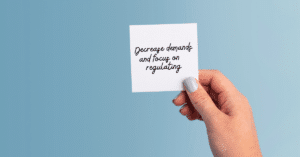Listen on Apple Podcasts Listen on Spotify
This Week’s Episode: The SLP’s role in Implementing Sensory Strategies
This month I have had the pleasure of chatting with Jessie Ginsburg. Jessie is the founder of Pediatric Therapy Playhouse, a multidisciplinary clinic in Los Angeles. She’s also contributed in a bunch of publications. You’ve probably seen her in the ASHA Leader.
Last week Jessie set us up with the importance of why SLPs should understand sensory processing in the speech room and I’m excited to continue the conversation!
Today we will discuss the SLP’s role in sensory strategies as this is typically reserved more for OTs.
Let’s dive in and get to the good stuff, shall we?!
Key Takeaways + Topics Covered
✓ The SLP’s energy plays a big role in helping regulate the student
✓ Sensory integration is meant to make long-term changes in the sensory system
✓ Different than using strategies to make sessions more effective
✓ Use a Seesaw as an example. It can tip (signs of dysregulation)
🌟 Decrease demands and focus on regulating 🌟
Additional Links
Jessie Ginsburg on Instagram: @jessieginsburg.slp
STAR institute (sensory-related trainings)
Jessie’s Sensory Certificate Program
Next Up in this Pod Series
5/3/22: A Crash Course in Sensory Strategies for the SLP: The Why
5/10/22: A Crash Course in Sensory Strategies for the SLP: Our Role
5/17/22: A Crash Course in Sensory Strategies for the SLP: Levels of Arousal
5/24/22: Crash Course in Sensory Strategies for the SLP: The Optimal Learning Zone
Subscribe & Review on iTunes
Are you subscribed to the podcast? If you’re not, subscribe today to get the latest episodes sent directly to you! Click here to make your listening experience auto-magic and as easy as possible.
Bonus points if you leave us a review over on iTunes → Those reviews help other SLPs find the podcast, and I love reading your feedback! Just click here to review, select “Ratings and Reviews,” “Write a Review,” and let me know what your favorite part of the podcast is.
Thanks so much!
Transcript
Marisha: Hello there and welcome to the SLP Now Podcast, where we share practical therapy tips and ideas for busy speech language pathologists. Grab your favorite beverage. And sit back as we dive into this week's episode.
Marisha: Hey, there it's Marisha. And today we are continuing our series on sensory strategies with Jessie Ginsburg. So in episode 118, we talked about the why. And then 119 talks about the SLPs role in sensory strategies. Episode 120 talks about levels of arousal and episode 121 talks about the optimal learning zone. So if you're listening in a little bit later in the series, definitely head back to 118 to get a really nice foundation before we dive into the other areas. And if you want to access the resources for any of these episodes, you can go to slpnow.com/ and then just add in the number of the episode. So slpnow.com/118 or slash 119, and that's the easiest way to access those resources. So without further ado, let's get back to the content. What would you say to SLPs who went to grad school and started working in a school, they didn't sign up for the program at USC, like how do you think that changes things? What do you think our role would be? And then maybe how can that role change as we do additional learning?
Jessie Ginsburg: Yeah, definitely. I think that with sensory processing it's like any other training that you would do post grad school. Most of us don't get a course on feeding therapy. Most of us have to go out after school and seek those additional courses and trainings in order to feel like it's ethical for us to work on that. So the training that I did through USC was called [inaudible 00:02:05] sensory integration and sensory integration is meant to create long term changes in the sensory system. That is separate than the idea of using sensory strategies.
Jessie Ginsburg: Our goal as SLPs is how can we use sensory strategies in our session just to change the child's level of arousal, trying to get them into a regulated state so that we can have more effective sessions. So I think that it's up to us to go out there and do these trainings, which I've tried to make a lot more accessible to SLP. Recently, I did a free sensory intensive that was four days long, teaching a lot about getting started with sensory. Yeah. Like you mentioned, I've written for ASHA about how we can start integrating sensory into our treatment. So there's definitely a lot to learn, but there's a lot that we could do and get started with really quickly.
Marisha: Yeah. That absolutely makes sense. And you gave some examples when you were sharing more of your story and it's totally fine if we repeat some of those examples, but can you illustrate a little bit about what that could look like in a typical session?
Jessie Ginsburg: Yeah. I'll give you an analogy that I use with parents and when I train therapists of this, I call it the sensory seesaw. But if you picture a seesaw and in my head, I just picture like a line with a triangle underneath it, right? Very basic, like seesaw is how I would draw it for parents in sessions. And I explained to them that a balanced seesaw represents a regulated child. This is when the child is in what I call their optimal learning zone. They are regulated, their body is ready to learn. And when we can get them in that optimal learning zone, that's where we want them to be in our sessions in order to get the most out of the session. So if you picture a tipped seesaw that would represent a dysregulated child. So when we see that our kids seesaws are tipping, so if we start to see little signs of dysregulation in our session, what is our goal in that moment?
Jessie Ginsburg: Is it to continue on with the activity at hand and continue to put demands on the child and let the seesaw tip further and further and further down, or is it to decrease demands, focus more on regulating and get the child back to a balanced state? And to me the answer is obvious that it is our job to bring the child back to this balance state of regulation. But I think if we always kind of have that visual in our minds of the seesaw. And where is the child in our session? Is the seesaw balance? And if not, what can we do to get him back there? And I've presented a lot with Jake Greenspan who's the son of Dr. Stanley Greenspan who created floor time.
Jessie Ginsburg: So we've talked a lot about kind of integrating floor time strategies. But something that he's mentioned before that really resonated with me is that for some kids, and the way I put this into my seesaw analogy is like, imagine the triangle and the seesaw wasn't in the middle. Imagine it was like to the left. And that means that maybe you can have a negative experience on one side, which tips a seesaw over so far, but it's not just going to take one positive experience to bring that seesaw back to center. It might take five, six positive experiences to bring that seesaw back to center.
Jessie Ginsburg: So I think that we can think about that in terms of the demands that we're putting on kids, is that when we do see that a child is dysregulated, it doesn't just mean that we could do one thing that they're going to enjoy to bring them back to center. It really might take a lot more positive experiences than that. So that's why the idea of like, how can we try to keep this child seesaw balance as much as possible when we see signs of it tipping, bring it back to center instead of letting it tip over all the way.
Marisha: Yeah. And I love that visual of the triangle and the seesaw moving because that can help put it into perspective a little bit. And even if that triangle is right in the middle, it might still take more than one positive experience too.
Jessie Ginsburg: Yeah, definitely. And I think like if we take the pressure off of ourselves to get whatever task done that we've got laid out for the session, and instead, how can we keep that seesaw balanced? Like what could we do in this session? How can we balance our demand so that we could keep this kid regulated, keep that seesaw balanced? Your therapy is going to look completely different if that becomes the focus of your session.
Marisha: Yeah. So if an SLP is interested in learning more and like really being able to feel more confident in their role with these strategies, what are some resources that you would recommend?
Jessie Ginsburg: There's a lot of resources that are not meant for SLPs. So there's a lot of trainings online. There's an Institute called the STAR Institute, which has all sensory related trainings. And then obviously there's these way longer, more expensive programs like the one that I went through at USC. But that's honestly like where my sensory certificate program came about was from this realization that I needed and SLPs needed these resources and they didn't exist for us.
Jessie Ginsburg: When I went through all of these courses, I learned so much, but a huge amount of it was completely irrelevant to me as an SLP. When I was in my courses, I was writing handwriting goals. Like it was not stuff related to what I was doing in speech. I had to actually go through all of that coursework and pull out the things that were related to what I was doing and then try to draw the connections. So I do still think the resources are really limited, which is why I ended up creating a program to teach SLPs about it, but also started doing a lot of free training for those who couldn't commit to the full program.
Marisha: Yeah. No, that's super helpful in knowing where we can potentially look. And I think that your Instagram account is also a great place to kind of start dabbling a little bit. The program is another amazing resource, if you are super ready to dive in.
Jessie Ginsburg: Yeah.
Marisha: Thanks for listening to the SLP Now Podcast. If you enjoyed this episode, please share with your SLP friends and don't forget to subscribe to the podcast to get the latest episodes sent directly to you. See you next time.
Sign up to receive email updates
Enter your name and email address below and I'll send you periodic updates about the podcast.




Reader Interactions